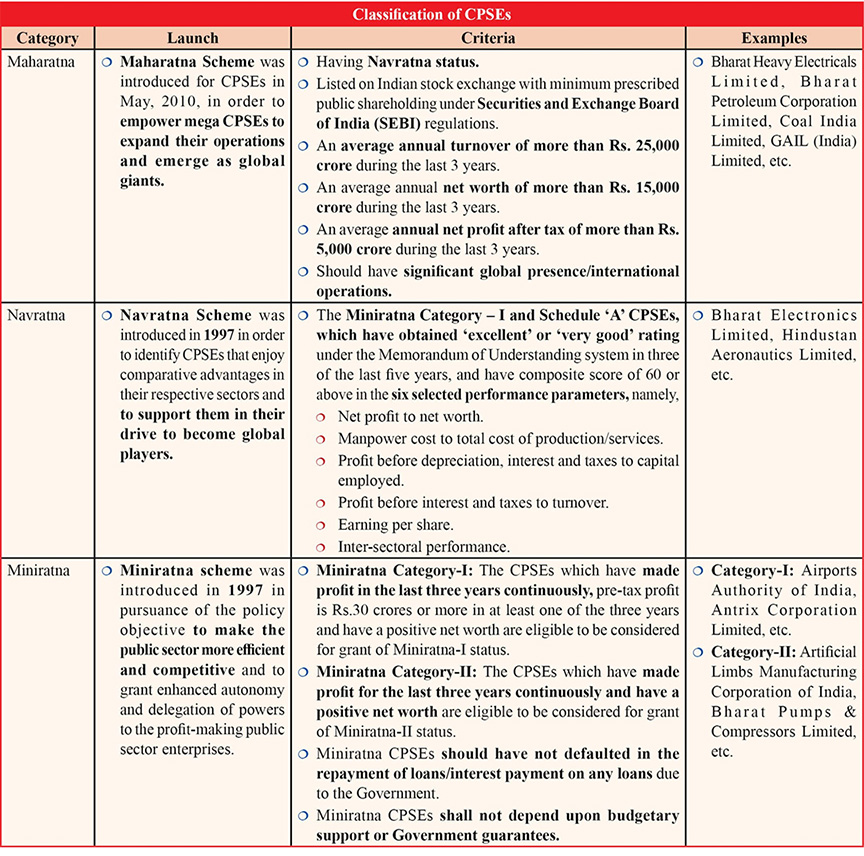Indian Economy
Annual Public Enterprises Survey
- 12 Aug 2021
- 4 min read
Why in News
Recently, the 60th Public Enterprises (PE) Survey 2019-20 was released by the Department of Public Enterprises (DPE), Ministry of Finance.
- It is the single largest source of information on Central Public Sector Enterprises (CPSEs) and acts as a basis for informed policy making.
- The government has reallocated the Department of Public Enterprises (DPE) to the finance ministry from the ministry of heavy industries.
Key Points
- About Public Enterprises (PE) Survey:
- PE Survey is a 100% enumeration of the CPSE universe. It captures essential statistical data for all CPSEs on various financial and physical parameters.
- PE Survey divides CPSEs into five sectors namely:
- Agriculture,
- Mining & Exploration,
- Manufacturing, Processing & Generation,
- Services,
- Enterprises Under Construction.
- The Department of Public Enterprises (DPE) started bringing out the Public Enterprises Survey from the financial year 1960-61 on the recommendations of the Estimates Committee of the 2nd Lok Sabha, 73rd report (1959-60).
- About DPE And CPSEs:
- DPE is the nodal department for all the Central Public Sector Enterprises (CPSEs) and formulates policy pertaining to CPSEs.
- According to DPE, CPSEs mean those Government companies, besides Statutory Corporations, wherein more than 50% of the share in equity is held by the Central Government.
- The subsidiaries of these companies, if registered in India, are also categorized as CPSEs.
- It does not cover departmentally run public enterprises, banking institutions and insurance companies.
- CPSEs are classified into 3 categories namely Maharatna, Navratna and Miniratna.
- Presently, there are 10 Maharatna, 14 Navratna and 74 Miniratna CPSEs.
- Role of Central Public Sector Enterprises:
- CPSEs in India have a twin objective of commercial efficiency and social responsibility.
- Besides contributing to the Government income, they discharge social obligations through their Corporate Social Responsibility (CSR) activities.
- The idea of CPSEs was conceived to eradicate the accumulated problems of:
- Unemployment,
- Rural-urban disparity,
- Inter-regional and inter-class disparities,
- Technological backwardness.
- CPSEs envisage to develop the public sector as an instrument for self-reliant economic growth.
- Before India got independence, it had only a few CPSEs.
- These included the Railways, Post and Telegraph, Port trusts, Ordnance factories, etc.
- Most CPSEs were set up after independence when the private sector had limited capacity for large capital intensive enterprises.
- Challenge: The challenge for these enterprises arises out of the need for them to ensure a reasonable return on investment, while discharging their constitutional and social obligations.
- CPSEs in India have a twin objective of commercial efficiency and social responsibility.
- Atmanirbhar Bharat Abhiyaan - Contribution by CPSEs:
- The CPSEs have taken a range of initiatives as part of the Atmanirbhar Bharat Abhiyaan towards meeting the Government of India’s ‘self-reliant India’ agenda.
- The initiatives include policy reforms, strategic partnerships, administrative actions, operational realignment and capacity building.
- The initiatives by the CPSEs can be divided under five broad categories as shown below:
- Enhancing local capacity to support Government’s larger strategic objectives.
- Promotion of cooperation between CPSEs to explore synergies.
- Providing a platform for greater participation of domestic firms/MSMEs.
- Rationalising import dependency to ensure long term sustainability.
- Development of indigenous technology and promoting technology transfer to CPSEs.





